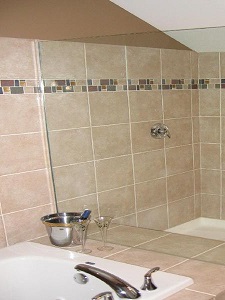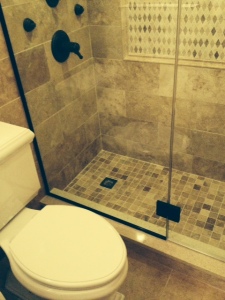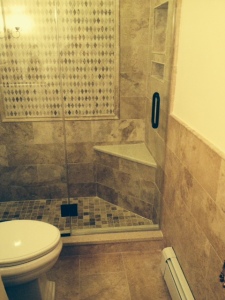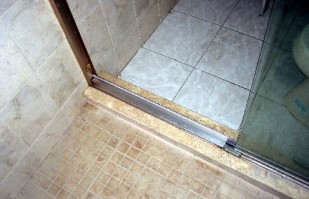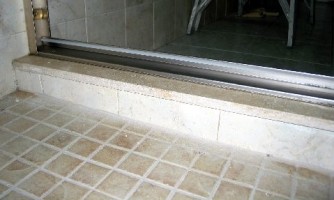Archive
How big is too big when it comes to the gaps…
Chris,
You provide great information in response to questions. I’m hoping you can help me with one I have. We just had a frameless shower installed. All walls are tile, the curb is solid granite. The glass is 1/2 inch with one panel fixed on top of a half wall and the other panel is notched and joins the panel on the wall (90 degree angle) and continues down to the granite curb. It’s a large space so we didn’t need any door. My question is about the notched panel. The tile is square edge but the notch is curved. The glass of the notch rests on the top of the half wall, but where the glass goes down the wall to the granite there is a gap of at least 1/4 inch that the installer filled with silicone. It seems too wide and way too much silicone to me. But I’m not the expert. Your thoughts?
Denise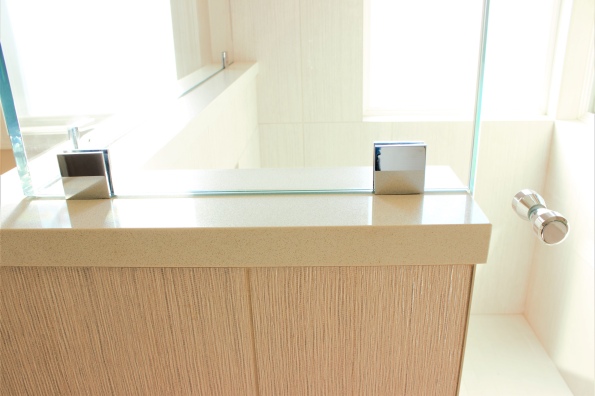
Hi Denise,
Thanks for your question. How big is too big when it comes to the gaps in your frameless shower enclosure? I’m sure different people will give you different answers… In my opinion, 1/4” is borderline. Generally speaking, we aim to have 1/8” gaps between the glass and the tile. Where the hinge side of the door meets the wall a 1/4” gap is normal. You have the back plate of the hinge, which is 1/8” thick, and the additional 1/8” clearance there. The gap from glass to glass (where the strike side of the door meets the fixed panel at the vertical gap) is normally 3/16”.
It’s important to keep in mind the limitations of the fabricator and the installer. The standard tolerance for frameless shower glass is plus-or-minus 1/8”. This is the industry standard… Although an installer may aim to make all of the joints 3/16” or less, it is not always possible if the glass is not fabricated exactly to specifications. In your case, I would have to say the ¼” gap is acceptable. If it were 3/8” or more I would not be satisfied, but there is little that can be done to prevent what you are describing. After all, it is only 1/16” larger than the ideal.
I hope you find this helpful,
-Chris
Buying Shower Doors and Enclosures Online
More and more people are shopping online these days. It is a convenient way to shop for a lot of different items. People even buy shower doors online, if you can believe it! There are a lot of options available, and some are actually quite good. Showcase Shower Door Company carries a full line of shower doors and enclosures manufactured by Fleurco. They are some of the finest shower enclosures you will find anywhere. We can offer our customers a complete package including the shower pan, glass, hardware, and instructions. All of this delivered right to your front door!
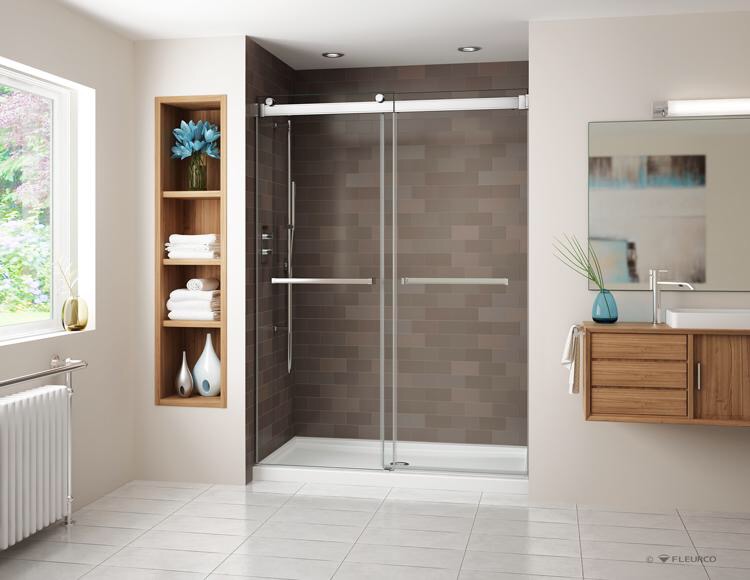
There is the challenge, however, of getting your shower enclosure installed once it arrives. We offer the service of installing customer-supplied shower enclosures for people in our area, whether they buy it from us or not. Wherever it is that you live, there is a good chance that there is a qualified shower enclosure installer available in your area. We here at Showcase Shower Door Company are taking steps to put together a network of quality shower door installers in different parts of the United States. We hope to be able to refer these experts to people who need their services. This will also allow shower enclosure manufacturers who sell their products across the country to take advantage of the skills of qualified installers in every area. Anyway, it’s something we are working on, and I’ll let you know as things develop.
Installing Customer-Supplied Shower Enclosures
We get calls from people who have purchased shower enclosures online and are looking for qualified technicians to install them. In the past, we have made it our policy to avoid installing customer-supplied shower door kits. There are so many different types of enclosures made by various companies… We have found it to be a good idea to just avoid the pitfalls of getting involved with installing them. We have vendors who can supply any type of enclosure that we are not able to manufacture ourselves, so it has made sense to us to install only the doors and enclosures the we sell.
Recently, glass barn door style shower enclosures have become very popular. I first became familiar with these types of enclosures when Cardinal came out with the “Skyline” series enclosure. This was the first frameless sliding enclosure of that type (to the best of my knowledge). It wasn’t long before other manufacturers began to make similar products. It took a while, however, to find any that matched the quality of the Cardinal version.
Today, they are common, and are likely all being made at the same factory overseas… We have started to take orders to install enclosures for people who have purchased them elsewhere, having become so familiar with them. There are other, even more innovative frameless sliding shower enclosures that have come on the market. One such product is the “Essence” series enclosure from C. R. Laurence. It utilizes 1/2″ tempered glass, and has no cross bar at all. This enclosure has become my favorite sliding shower door to install. It’s AWESOME!
For more information, feel free to get in touch.
-Chris
RE: Just One Bracket (?)
Chris,
As shown in the attached picture, our contractor installed our new glass shower panel using only one bracket (along the tiled wall near the top of the panel). A clear adhesive (supposedly “the best material in the business”) was also used along that tiled wall, as well as along the bottom of the panel where it meets a plank tile threshold atop – hopefully – proper shimming).
I can’t find another example of just one bracket being used on anyone’s glass shower panel, anywhere on the internet. Should I be concerned, not just for aesthetics, but also for safety?
Thanks,
Bill
Hi Bill,
We use shower door engineering software from C.R. Laurence to design our enclosures. In order to meet their minimum standard for structural support at the bottom, two brackets or a channel securing the bottom edge are required. I am aware that other shower door companies sometimes use one clamp at the bottom and two clamps on the vertical edge of the glass, but never one single clamp on a panel like the one shown in you photo. This is the first time I have ever seen something like that.
Silicone really is about the best material in the business… I’m guessing that is what was used here? The truth is that the silicone alone probably does have enough strength to keep the panel secure without any other mechanical fasteners. But the only legitimate reason I can see for someone doing it that way would be for looks. It doesn’t sound like you particularly like how it looks, though. I think the most logical explanation for this is that someone forgot the cutouts for the clamps at the bottom of the glass panel, and now they are pretending they meant to do it that way.
Whenever we sell a frameless shower enclosure, we supply a sketch of how it will look when completed. It is a good policy to make the contractor do that for you. Then you can compare the finished product to the sketch and see how close they are to one another. We all make mistakes sometimes. When that happens, it is best to just do the right thing and buy new glass. It never pays off, in the long run, to try cutting corners.
Thanks for writing,
-Chris
Frameless Shower Enclosure Channels
Chris,
I have seen frameless showers with the glass resting in metal channels where it contacts the tile, you have also discussed recessing the channel into the tile (butting the tile up to both sides of the channel). Are there any pros and cons to having the channel on top of the tile vs recessed. I can imagine if on top, the channel weep holes will drain water, but if recessed it seems it wouldn’t and enable mold growth.
Thanks for all the great advice.
Connell Smith
Hi Connell,
I think that your assessment of the options is pretty good. It’s actually kind of unusual for people to do the recessed channel with shower enclosures… there are some issues with preventing water infiltration. If you do imbed the channel, you are going to need to add a lot of silicone to prevent any water leaking into the floor below. Once water gets in, there will be no way for it to get back out again. On the other hand, having the channel on top of the tile will allow for weep holes (as you described), and go a long way to prevent water damage in the future.
Thanks!
Glass to Glass Hinges and Fixed Panels
Hello,
I saw your blog and I wanted to know if you think our shower doors are safe. We got them installed today and because the hinges are not attached to the wall the entire panel moves when you open the door. It takes effort to open the door. The track is adhered to the walls and saddle with silicone. Will that soften over time? My fear is this thing will fall down over time.
Thank you for your input.
Jennifer
Hi Jennifer,
I know exactly what you are talking about. There is a standard formula for the maximum width a fixed panel should be if it has a door hinging from it. It varies a little depending on the thickness of the glass (1/2″ or 3/8″). If the panel exceeds the recommended width, the whole enclosure will move the way that you are describing.
I can’t make a judgement call based on your photos since there are a lot of factors that I am unable to determine. Chances are that your shower enclosure is safe. I doubt that the force required to open the door will soften over time. The hinges are spring loaded to cause them to center themselves… that is the resistance you feel when you pull on the door.
It is also possible to add additional support to the top of the fixed panel if you feel you might need it. You can talk to the original installers about that.
Best wishes,
-Chris
Glass Panel Problem
hello, we have a problem, we installed a glass panel with silicone in the track, Is there a solvent or some product that will dissolve the silicon, we tried lacquer and it didn’t work, Any ideas other than breaking it, don’t want to do that. As we just had it all tiled,,
Thank you,
Marge and Ron
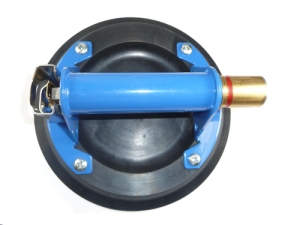

Hi Marge,
Great question! There are some products that claim to cut through cured silicone… these solvents usually require leaving them to work for 24 hours or so. I can’t say that I have much experience with using them, as I normally don’t have that much time to spare working on a job. You can give that a try, and it may work for you… just look in the paint department of your local do-it-yourself store, or ask for help.
A more sure-fire way to get the glass out in one piece will require a couple of tools. One is the trusty glass vacuum cup shown above. There is little chance that you are going to have any luck with getting the glass out whole without one of these. It will allow you get the kind of grip on the glass that you need to pull it out of the track as the silicone loses adhesion. The other tool I would recommend is a multi-tool with a very thin blade. I like the Dremel brand multi tool. It’s affordable, and does a great job. This will allow you to get a thin blade in between the glass and aluminum channel, and will make the job much easier.
All that being said, be sure to do everything possible to WORK SAFELY! The glass may break, no matter how careful you are. That is just the nature of glass. Even if the glass is tempered “safety” glass, it can still cut you! Be careful, and if you have any doubts at all, call in an expert.
Thanks for your email,
-Chris
No Weep Holes?
Hi, Chris.
We had one of our baths redone a few years ago but the apartment has been empty ever since as we were away from the country. A the time, a frameless door was installed and we never thought about looking for weep holes on the track until now that we found your blog. The shower has never been used so we don’t know if water would collect on the track.
Our question: Is there such a thing as a shower door track without weep holes? The photos show –instead of a conventional channel– a sloped, low lip on the side of the pan with no room for holes even if we wanted to drill some. Our guess was that, with this type of slanted lip, weep holes are not needed as water will just slide down onto the pan. We also checked if the track has been installed with the wrong side facing the pan but we failed to find weep holes on the other side as well.
Your clarification will be greatly appreciated. All the best to you.
Diana
Hi Diana,
Great question! Actually, this type of shower enclosure doesn’t require holes in the frame in order for the water to weep. The “L” shape of the bottom sill allows the water to run off back into the shower. As a rule, the sill is caulked on the outside only, or the inside is only partially caulked. This allows water the finds its way under the sill to escape, or at least dry out over time.
Thanks for reading the blog!
-Chris
Help.
Hi Chris:
I was so happy to see your website and was wondering if u can give me any advice. I have a fixed shower panel where it is secured at the bottom with U Track type of metal. My contractor guys forgot to seal it in the beginning so water got in and leaked outside. After I informed them of the problem they came back and put clear silicon seal around the bottom. Everything was good for about 6 months. And now I’m noticing black stuff (I’m assuming it’s some kind of mold) inside the silicon seal and INSIDE the track! Is there any way I can clean it out? and after cleaning it out (hopefully) how do i seal again? Is silicon caulking enough? or is there any kind of seal strip i should add?
thank you very much for your help!
Charlotte
Hi Charlotte,
Thanks for reading my blog. It looks like the caulking was applied after the water was already in the channel. Once the mold began to grow, it was trapped inside. Since the glass is clear, the mold is highly visible… In order to fix the problem, the glass is going to need to be removed from the channel. I would clean it thoroughly, and use bleach to make sure that the mold is completely eliminated. Only then should the glass be replaced, and the silicone seal reapplied. Make sure that the glass and channel are nice and dry before you do so. There is also a type of silicone that is “mildew resistant.” This is the type you are going to want to use. It has a fungicide in the formula, and will help to prevent the mold growth. Apply the silicone where the metal and glass meet to prevent water from entering the channel.
Best wishes,
-Chris
Shower Door Issues – Buyer Beware!
Hi Chris,
I was so happy to see your web site and hope to find some answers to some of our shower questions. In the master bathroom we installed a frameless shower door with L shape panels. After about 3 weeks the door was hitting the glass panel. We had the installer come out and all he does was tighten up the screws in the wall. It works for about a month and then we have the same problem. We have done this several times which resulted in a cracked tile. I have also noticed the wall the shower door is attached to is now bowing a little in the middle. Is there a fix to this?
Secondly, in our other bathroom we are experiencing major water leaks coming from underneath the door. Our installer says we have a water problem not a installation problem. I’m not sure what he meant by that but either way he will not be return to our home again. My husband and I would like to take down the shower door and panel (after spending so much money and time into it) because it just does not work. The problem we are having is that the U channel our installer screwed on to the wall is full of silicone and we can not remove the glass panel from it. We have scraped as much silicone out as we can but it is not budging. Is there anything we can use to detach the panel from the U channel?
Thank you for all your help!
Mike
Hi Mike,
I’m sorry to hear that you are having so many problems with your shower doors! The silicone is a very strong adhesive, as you have found out already… Without actually being there, it is kind of hard to know what to do, but I’ll try to give you a couple of suggestions. I would try a very thin putty knife, something thin enough to slide in between the aluminum and the glass on the inside of the channel. Try running it all the way up and down both sides of the glass to see if that is enough to allow the glass to come loose. This is a situation where I would use a glass-setting vacuum cup, but you probably don’t have one. It would allow you to get some leverage on the glass and apply a lot of pressure to try to get it loose.
One other option, if you can’t get the glass out of the channel, is to try to get between the channel and the tile to cut the screws off. A thin saw blade may allow this, but it is also likely to mar the tile. Give these things a try, and get back to me and let me know if you are having any success.
Best wishes,
-Chris

